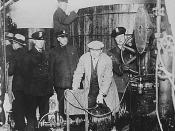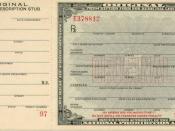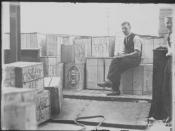Toni Carter
Discover New York 566
Professor Turner
May 4, 2014
The rise and fall of prohibition
"Prohibition did not achieve its goals. Instead, it added to the problems it was intended to solve" (Thorton, 15). Prohibition was a time in the United States between 1920 and 1933 where the production, sale, transportation, and importation of intoxicating liquor were banned. Legislation, known as The Volstead Act, was enacted to help carry out the Eighteenth Amendment, which was Prohibition. This determined that intoxicating liquor was anything with alcohol content over 0.5 percent. This act also determined enforcement (Bowen, 154). With passing this law, society hoped that it would decrease crime, poverty, death rates, and improve the economy and the quality of life. The Eighteenth Amendment was poorly written and had many loopholes that helped citizens still consume and have alcoholic beverages without breaking any of the laws. The Eighteenth Amendment was unenforceable; when the law was passed it caused a higher crime rate and increased amounts of alcohol consumption.
Bootleggers were importing alcohol from Canada and overseas, "Many people hid their liquor in hip flasks, false books, hollow canes, and anything else they could find" (Bowen, 159). Illegal Speakeasies were built to replace saloons at the start of the Prohibition. Speakeasies were establishments that illegally sold alcoholic beverages during the Prohibition era. "By 1925, there were over 100,000 speakeasies in New York City alone" (Bowen, 160). When passing this law, the government thought that this would be an easy task. Prohibition was easier proclaimed than enforced. There were only 1550 federal agents and over 18,700 miles of "vast and virtually unpoliceable coastline". It was nearly impossible to stop liquor from being imported into the United States.
The United States suffered from a high crime rate as a result of the...


